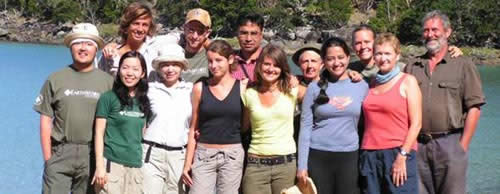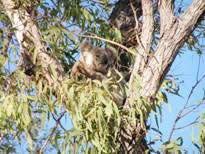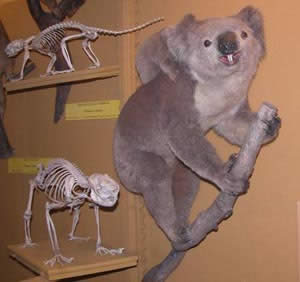
October 2006 Earthwatch trip to St Bees Island - Alistair Melzer
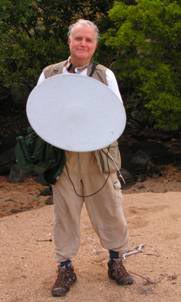
United States radio science producer, Jim Metzner, joined the team for four days Jim is holding his field tape recorder and parabolic reflector dish used to gather and focus certain sounds
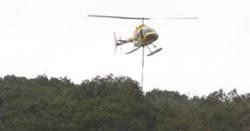
A helicopter was used to place fencing material at otherwise inaccessible locations
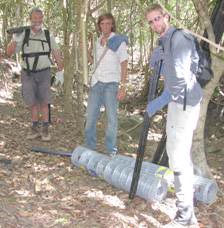
Some fencing material was transported by “pack-men” Alistair, Fred and
Andy
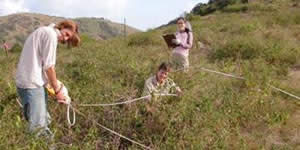
Fred and Cherry assist Rhonda Melzer (QPWS) map the vegetation within
the plots
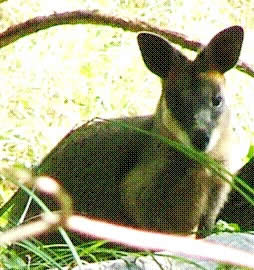
The Swamp wallaby and its faeces on St Bees Island. Browsing by this wallaby may impact on Blue Gum seedling survival

The faecal pellets will contain the information on what the wallabies are eating
Pete assists Alistair in measuring the canopy cover within plots.
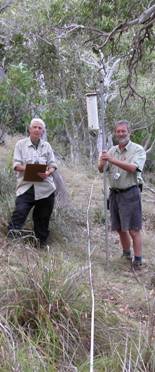
Despite the difficult weather conditions we gathered some good data. Forty koalas were sighted, 95 day radio tracking records made, 264 trees measured, three skeletons collected and 14 vegetation transects surveyed. As usual, koalas used different trees by day than by night. Despite some rain the fauna and some flora seemed stressed. Goats were feeding on the beach and have denuded the gardens around the houses. They are eating the coastal scrubs – stripping the bark of many trees. Some swamp wallabies were weak and slow moving. There were no indications of joeys. A number of Blue Gums (Eucalyptus tereticornis) had died and two koalas that we have tracked for many years had died.
I would like to take this opportunity to wish all members the
compliments of the season
Alistair
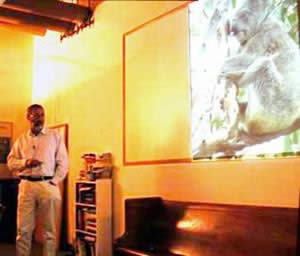
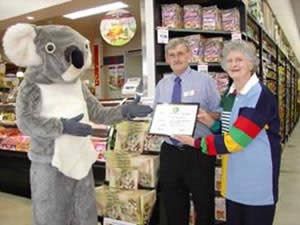
Shirley and Cuddly (Nick Quigley) showing their appreciation to Glenmore IGA store manager, Bruce McFarlane.
Koala Chocs
Supa IGA store at Glenmore have asked that we supply them with Koala Chocs until Christmas and this will be a welcome source of income with little exertion on our part. It is hoped to get our chocs into other Supa IGA supermarkets in 2007 and we are grateful for this support as we receive the total proceeds.
Next
Meeting
Monday 29th January 2007 commencing 5pm
Meeting Room Greg Turner Building CQU Campus
Our latest fundraiser is our UGLIES jerseys which are produced by Canterburys (makers of football jerseys). It is a quality product made from the left overs from the fooball jerseys. They are very colourful, mostly individual and have our colourful logo. They are long sleeved with a knitted cuff and a cotton fabric collar. In our part of the world, they would be ideal for winter.
The sale price $50.00 plus $2.50 postage and handling. They come in Medium, Large XLarge and up.
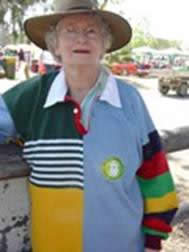
If you would like to know how we spend our funds, then join the group and become a Koala Volunteer My best wishes for the festive season.
Shirley Hopkins
Springsure – September 2006
The past few months have been rather busy with field work, preparation of computer analysis procedures, as well as communication with several different organizations in order to acquire climate, bioregion and soil data for each of my study sites in Queensland. Some of the more interesting activities included two field trips in September and one in October. The first was northwest, near to Collinsville. The trip was very successful and I saw my first, of many, wild koala since I have arrived in Queensland. We saw what we believed to be 11 individuals, with the possibility of 12, but it is most likely that number 12 was previously observed the day before and moved trees over night. I also had an opportunity to spend a good deal of time with the landowner of the property, which allowed me to learn history of the land, issues surrounding the management of the property as a State Forest, and the potential interruption to the area by further development of the Queensland Railroad near and through the property. It was a great opportunity for me to learn first hand some issues which are facing property owners as well as managers here in Queensland. These types of interaction always provide me with a new perspective about managing land as well as species in this “new to me” environment. While I learned a lot from Jennifer Cowan, the landowner, I also noticed that issues surrounding property owners are quite similar to those issues which I encountered in my studies at University in the United States. This similarity in management and land ownership “issues” provided for a unique conversation between Jennifer and me.
The conversation was enlightening and inspiring for me, as I heard first hand from a concerned property owner who wants the best for the environment and goes out of her way to do the best she can to protect her land not only to raise healthy and well looked after livestock, but for protecting the native wildlife as well. My next trip was southwest of Rockhampton, to Minerva Hills National Park near to Springsure. I had the pleasure of taking the Centre for Environmental Management’s new French interns, Ophélie Beets and Charlotte Baudry, along for the trip for them to experience one of the environments in which koalas occur in central Queensland. Unfortunately, we did not see any koalas on the trip. Yet, we saw a large amount of koala faecal pellets under a number of blue gum and ironbark trees near an ephemeral creek, with fewer pellets found under bloodwood trees further from the creek. While we didn’t get to see any koalas, we did see a number of other native wildlife during our three hours of spotlighting (e.g. several species of wallaby, kangaroos, and an echidna). The trip offered a unique opportunity for Charlotte and Ophélie to see ecosystemsas a number of wildlife which they had never seen in the wild before. I gained further knowledge about the difficulties associated with spotting koalas in the wild in central Queensland, and I hope that when I have more time during my sampling period that I will be able to observe a koala at Minerva Hills National Park, as we know they are there because the of the large amount of fresh koala pellets. In October I had the opportunity to join Alistair and group of volunteers, including Charlotte and Ophélie, on an Earthwatch trip to St Bees Island off the coast of Mackay, Queensland. While there were a number of unique and amazing things to write about from this trip, I would like to provide you with the opportunity to read about my favourite experience on the trip. The most unique experience I personally have had the opportunity to observe was that of several koalas’ activities and patterns of a 24 hour cycle. This project is credited to Charlotte, but I too was able to spend an extensive amount of time in the field observing two of the three female koalas. I would like to share my observation of a mother koala, Natasha, and her interaction with her joey during the late hours of the night. The following observations is a shortened version of what will be included in Charlotte’s report, but I thought it would offer a unique opportunity
for the CQ volunteers to hear of such a unique observation of a koala and her joey. “…The interaction began with Natasha and the joey both moving up approximately
0.5 m in the tree. Next, Natasha began to communicate with the joey, making small and short shrill noises as she was pushing the joey away from her in the tree. Natasha seemed to want the joey to move down the tree, but the joey was not interested and communicated this back with similar noises and grabbing towards Natasha. Communication between the two began again at 2305 and continued for ten minutes. The communication ended at 2315 as the joey began to move slowly down the tree and at 2320 the joey had moved onto the ground and walked very slowly away from the tree. Within ten minutes the joey had walked past the two observers and slowly made its way across a cleared area into a grassy understory…” While this is a brief and simple observation, it is very interesting and provides insight into the types of interactions which may occur between a mother and a joey as the joey is “learning” and being forced to leave the mother for an extended period of time, beginning to travel on the ground and to other trees. In addition to the field work and observations, the trip was a great opportunity to interact with a number of volunteers from all different walks of life and from all over the world. It was an experience which provided me with further field training, as well as the opportunity to learn the importance of planning and the types of surprises which can occur when working with volunteers and conducting field sampling.
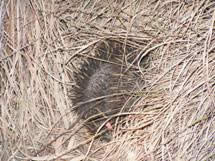 Echidna sighted during night spotting |
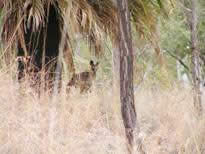
Whiptai wallaby (?) at Minerva National Park Springsure September 2006 |
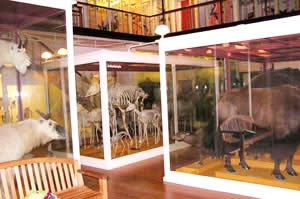
A general view of a small portion of the collection at the Museum of Natural History. The articulated skeletons of whales hang from the ceiling above. Stuffed birds are visible on the mezzanine floor. There are a number of other rooms housing specimens from most continents and major biomes.
In the Winter Edition of the newsletter, I reported that Nick had been awarded the OAM in the Queen’s Birthday Honours. Below are some photos from that wonderful occasion. Once again, congratulations from all of us to Nick.
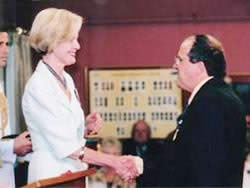
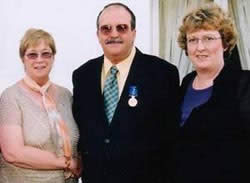
Nick receiving his award from
Governor Quentin Bryce AC
